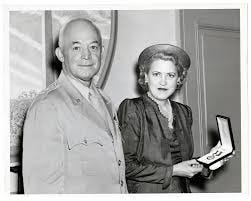Notable "Firsts" for Women in History
In 1967, Katherine Switzer was the first woman to run the Boston Marathon -- but once her gender was identified, officials physically tried to remove her from the race creating havoc.

It’s been a man’s world from the beginning. Yep, men have dominated every single aspect of life on this planet. Regardless of culture, country or region, man has been the leader of the home, the government, the business, and education. You name it, and men have been the leaders and decision-makers, portraying women as less than and, dare I say, inferior to the superior male population.
Very sad - but true. I cannot believe I’m even writing such words about humanity and our nature as a species. But as we slowly hold a mirror up to ourselves, we see the reality of our history as a society.
It wasn’t until the late 19th century and into the 20th that a shift began to take place. The rise of feminist movements and social changes began challenging male-dominated paradigms. Women increasingly demanded equality, autonomy, and representation, leading to greater access to education, voting rights, employment opportunities, and even participation in a marathon.
I thought it’d be fun to continue my essays on notable “firsts” for women. As you’ll see, it took tremendous courage for some to challenge the status quo, while others simply wanted to follow their passions regardless of the perceived consequences.
For example, as the first woman to run a Boston Marathon was in progress, officials physically tried to remove her from the race.

As late as 1967, marathons were still a man's sport, like so many sports, too much for the fragile woman. Katherine Switzer thought otherwise, though. She registered under a name that hid her gender, K.V. Switzer. Once the race started and her identity was discovered, officials tried to force her from the race.
Katherine tells her story in this short video. It’s a cool story and one that changed women's sports forever!
An excerpt from the New York Times:
Of her legacy as a pioneer, Katherine Switzer wrote in The Times: “We learned that women are not deficient in endurance and stamina and that running requires no fancy facilities or equipment. Women’s marathoning has created a global legacy.”
“In 1967, few would have believed that marathon running would someday attract millions of women, become a glamour event in the Olympics and on the streets of major cities, help transform views of women’s physical ability and help redefine their economic roles in traditional cultures,” Switzer wrote.
First Woman to Climb Mount Everest:
Junko Tabei (1939–2016) was a pioneering Japanese mountaineer and environmentalist, best known for being the first woman to reach the summit of Mount Everest on May 16, 1975. She also became the first woman to complete the Seven Summits, the highest peaks on each of the seven continents, solidifying her place in history as one of the most accomplished climbers of her time.
Early Life and Love for Climbing
Born on September 22, 1939, in Miharu, Fukushima, Japan, Junko Tabei developed a love for climbing at a young age. She went on her first mountain expedition at the age of 10, scaling Mount Nasu, a volcano in Japan. However, growing up in a conservative society, Tabei often encountered discouragement, as mountaineering was considered a male-dominated sport. She was undeterred by these societal expectations and continued to pursue her passion for climbing throughout her life.
Tabei attended Showa Women’s University, where she earned a degree in English and American literature. Despite facing gender discrimination in the climbing community, she formed a women’s climbing club in 1969, called the Ladies Climbing Club Japan (LCC), with the motto, "Let’s go on an overseas expedition by ourselves."
Climbing Mount Everest
In 1975, Tabei was chosen to lead an all-female Japanese expedition to Mount Everest. The journey was not without its challenges—just 12 days before reaching the summit, the team was struck by an avalanche that buried their camp. Tabei lost consciousness for six minutes but was revived by her teammates. Despite the setback, she pushed forward and, on May 16, 1975, became the first woman to reach the top of Mount Everest, standing 29,029 feet above sea level. Her achievement garnered international acclaim, and she became a symbol of perseverance and determination.
Legacy and Death
Junko Tabei’s accomplishments not only broke gender barriers in mountaineering but also inspired countless women and men around the world to pursue their passions, regardless of societal expectations. She is remembered not only as an extraordinary climber but also as an advocate for the environment and for women’s empowerment.
Tabei continued to climb into her later years, even after being diagnosed with cancer. She passed away on October 20, 2016, at the age of 77, leaving behind a legacy of determination, environmental stewardship, and courage.
First Female Pilot in the U.S. Armed Forces:

Jacqueline Cochran (1906–1980) was a pioneering American aviator, businesswoman, and a key figure in the history of women in aviation. She broke numerous records in flight, was a trailblazer for women in the U.S. military, and became the first woman to break the sound barrier. Cochran’s remarkable career in aviation, combined with her contributions during World War II, made her one of the most accomplished and celebrated female pilots in history.
Early Life
Jacqueline Cochran was born on May 11, 1906, in Pensacola, Florida, into a poor family. Originally named Bessie Lee Pittman, she grew up in poverty and had limited formal education. As a young woman, she reinvented herself, changing her name to Jacqueline and pursuing a career in beauty and cosmetics. Her drive and ambition led her to New York City, where she worked as a hairdresser and eventually started her own successful cosmetics company.
Cochran’s life changed in the 1930s when a friend suggested she learn to fly as a way to expand her cosmetics business. She took up the challenge and quickly developed a passion for aviation. After just a few weeks of flight lessons, Cochran earned her pilot’s license in 1932.
*** Special NOTE: When you “like” “comment” or “share,” this post, it helps others discover my newsletter. Please consider clicking “like” at the top or bottom of this post. Thank you! ****
Aviation Career and Achievements
Jacqueline Cochran quickly established herself as a prominent aviator. In the 1930s, she began competing in air races and set a number of records for speed, altitude, and distance. In 1938, she became the first woman to win the prestigious Bendix Trophy Race, a transcontinental air race.
Cochran’s aviation accomplishments continued to accumulate:
First Woman to Fly a Bomber Across the Atlantic (1941): In the early days of World War II, Cochran flew a bomber across the Atlantic Ocean, becoming the first woman to do so.
First Woman to Break the Sound Barrier (1953): On May 18, 1953, she became the first woman to break the sound barrier while flying an F-86 Sabre jet. She reached a speed of 652 miles per hour, a groundbreaking achievement in aviation history.
World Records: Cochran set more than 200 aviation records during her career, many of which still stand. She held records for speed, altitude, and distance, and she was the first woman to take off from an aircraft carrier.
Role in World War II: The Women Airforce Service Pilots (WASP)
During World War II, Jacqueline Cochran played a crucial role in the creation of the Women Airforce Service Pilots (WASP) program. In 1941, she became one of the first female pilots to ferry aircraft for the British Royal Air Force as part of the war effort. Recognizing the need for more pilots in the U.S., Cochran advocated for a similar program in the United States.
In 1943, the WASP program was established, and Cochran was appointed its director. The program trained women to fly military aircraft, freeing up male pilots for combat duty. Under Cochran’s leadership, over 1,000 women were trained to fly various types of military planes, including bombers and fighters. The WASP program was a significant step forward for women in the military, although it wasn’t officially recognized as a military service until decades later.
Post-War Achievements and Later Life
After the war, Jacqueline Cochran continued to break barriers in aviation. She became the first woman to land and take off from an aircraft carrier and the first woman to fly a jet across the Atlantic Ocean. In the 1950s and 1960s, she set several world records for speed and altitude, solidifying her status as one of the world’s greatest aviators.
Cochran’s influence extended beyond aviation. She was active in politics and business and served as a consultant to NASA during the early years of the space program. She remained an advocate for women’s involvement in aviation and space exploration.
Legacy and Death
Jacqueline Cochran passed away on August 9, 1980, at the age of 74. She left behind a legacy of breaking barriers and setting records that few, if any, could match. Her contributions to aviation and her role in advancing the role of women in the military have cemented her place as one of the most influential figures in aviation history.
Cochran’s numerous awards and honors include being the recipient of the Distinguished Service Medal and being inducted into the National Aviation Hall of Fame in 1971. Today, she is remembered as a trailblazer whose determination and skill helped redefine what was possible for women in aviation.
If you want to support my work, you can tip me by buying me a cup of coffee.












Great post, Eddie